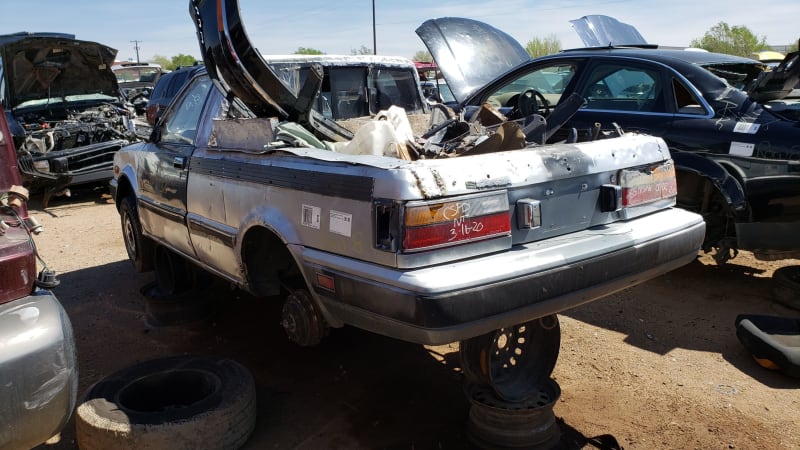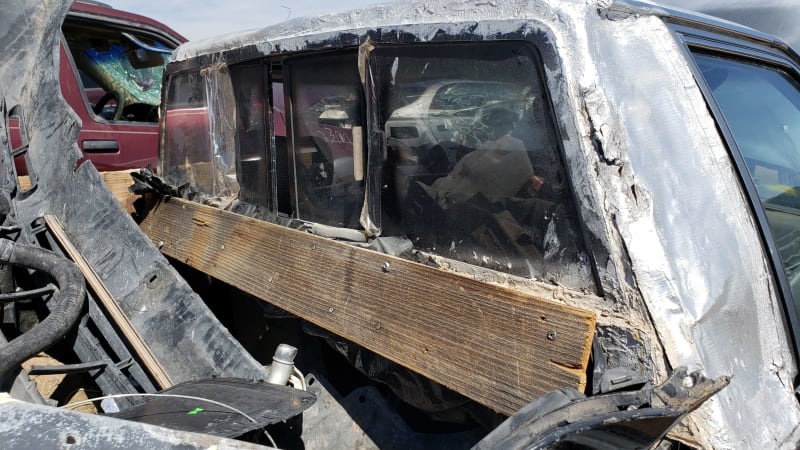If you want to study the ingenuity deployed by backyard fabricators who convert ordinary commuter cars into cargo-haulin' pickup trucks, you can't beat your local car graveyard. When someone has a fully depreciated car and the means to do some cut-and-paste action with that car's steel, all it takes is the desire to own a pickup to begin the process. These homemade trucks tend to get discarded after being used a few times, giving me the opportunity to evaluate their construction techniques. Here's such a vehicle: a 1985 Nissan Stanza four-door hatchback converted into a credible pickup truck, found in a Colorado Springs yard a few months back.
Because of the influence of the iconic Chevrolet El Camino, the name for a car converted into a truck may be determined by using the following formula: Model Name + mino. So, Stanzamino! This naming convention goes back to the days when I vied with Jonny Lieberman and the late Davey G. Johnson to find the best -aminos. Not all such vehicles get the -amino naming treatment, however. Because Ford built the Ranchero and Dodge built the Rampage based on car platforms, you refer to Ford-based homemade trucks by appending -chero to the model name; Chryslers subjected to this treatment have -page welded on to their names. Thus, Stanzamino!
Over the years, I've documented plenty of such -aminos, -cheros, and -pages in junkyards around the country, including this '95 Tauruschero, this '97 Neonpage, and this '90 Metroamino.
One challenge you'll find when building your own pickup comes at the rear of the vehicle. Adding a functional tailgate while retaining the factory taillights and license-plate mount would add many hours of tedious, finicky fabrication to the project, so most -amino builders just skip that part and live with lifting cargo in and out of the bed. This Stanzamino has a stub of the lower hatch welded into place, a nice touch that minimizes sharp edges.
It appears that the S got broken off the Stanza badge during the process, so a replacement was glued on.
The other big hurdle facing the -amino builder comes when converting the front portion of the passenger cabin into a truck cab. How do you seal off the cab from the elements, once you've sliced away the upper rear body? The builder or builders of this Stanzamino went for a combination of tape, wood, sheet-metal screws, caulk, body filler, wallpaper paste, cornbread batter, mucilage, oakum, cardboard, adobe, beeswax, spray foam and lots of silver spray paint.
What appears to be a genuine pickup-sourced sliding rear cab window went behind the seats.
However, the lower portion of the partition between cab and bed was made of trashbags taped across the opening. This may have resulted in some occupant discomfort during periods of below-zero temperatures in winter, not to mention issues with exhaust gases getting into the cab and heavy cargo items ramming into the back of the seats under hard braking.
On the plus side, the rear doors were cut and welded nicely by -amino standards, and the rub strips really help hide the former four-door configuration.
This Stanzamino went to its grave with barely over 100,000 miles on the odometer.
The 2.0-liter, fuel-injected CA20 engine in this car sent 97 horsepower to the front wheels when it was new. That's not enough for hauling a couple tons of concrete up Pikes Peak (located within sight of this yard), but it puts this machine in the same front-drive pickup league as a Rampage or Volkswagen Rabbit Pickup.
The automatic transmission added luxury.
A good example of a functional homemade truck, built on time and under budget.
[embed]https://www.youtube.com/watch?v=zqDfyNf8TWw[/embed]
Did this truck's owner wear a white suit and straw boater while driving? We may never know.
[ad_2]
Source link












